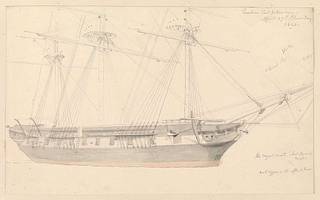
Annotated drawing of 'Larkins East Indiaman, April 27th (Thursday) 1843' RMG PY3776
Summary
Annotated drawing of 'Larkins East Indiaman, April 27th (Thursday) 1843'
No. 5 of 30 (PAH3772 - PAH3801)
If the inscription on PAH3777 is correctly read, Schetky made drawings of the 'Larkins' in the East India Docks. Schetky urged his students to draw everything and to annotate their drawings ‘No doubt you are sketching every day. Now I advise you to make minute studies of every kind of boat …, and draw the inside of them as well as sheer and shape – ay, the inside, with all the gear you see in them – nets, crab pots, spars, casks, sails, and everything, most carefully, marking the colours of each, and depend upon it you will find the good of it hereafter.’
The drawing is annotated with details of the rigging and inscribed and dated in the upper right 'Larkins East Indiaman-/ April 27th (Thursday) 1843'.
Annotated drawing of 'Larkin's East Indiaman, April 27th (Thursday) 1843'
The British East India Company was the first joint-stock corporation to be formed in England, and it eventually became one of the most powerful trading companies in the world, with a virtual monopoly on trade in India and the East Indies. The East India Company or the British East India Company and informally as John Company was an English and later British joint-stock company, which was formed to pursue trade with the East Indies but ended up trading mainly with the Indian subcontinent and Qing China. After the defeat of the Spanish Armada in 1588, London merchants presented a petition to Queen Elizabeth I for permission to sail to the Indian Ocean. Permission was granted, and on 10 April 1591 three ships sailed from Torbay around the Cape of Good Hope to the Arabian Sea. On 31 December 1600, the Queen granted a Royal Charter to "George, Earl of Cumberland, and 215 Knights, Aldermen, and Burgesses" under the name, Governor and Company of Merchants of London trading with the East Indies. The governance of the company was in the hands of one governor and 24 directors or "committees", who made up the Court of Directors. They, in turn, reported to the Court of Proprietors, which appointed them. Ten committees reported to the Court of Directors. According to tradition, business was initially transacted at the Nags Head Inn, opposite St Botolph's church in Bishopsgate, before moving to India House in Leadenhall Street. The company played a key role in the spread of British influence in India and the development of the British Empire. However, it also became involved in corruption and exploitation, and it was eventually dissolved in 1858, following the Indian Rebellion of 1857.
Tags
Date
Source
Copyright info
























